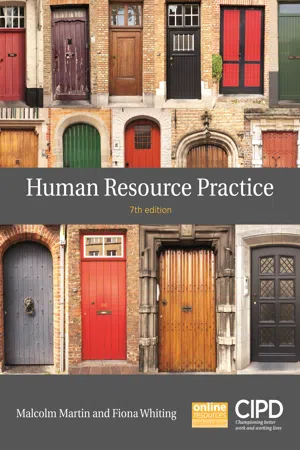
- 328 pages
- English
- ePUB (mobile friendly)
- Available on iOS & Android
Human Resource Practice
About this book
Human Resource Practice provides a practical and accessible guide for students and anyone looking to gain a thorough understanding of HR, and is the definitive text for the CIPD's Level 3 Foundation Certificate in HR Practice. International case studies, examples and activities enable the reader to engage with the key areas of practical HR management, including the legal background to employment, learning and development, change in organizations and employee relations. This fully updated 7th edition of Human Resource Practice explores the application of models within the practice of HR, including the Ulrich model, timely discussion on employee engagement and well-being in the workplace, and further information on the practical elements of HR, including law, recruitment and selection, performance management and reward. From two renowned experts in HR practice, this clear and in-depth text will provide you with all the skills and information that you need for a successful career in HR. Online resources offered are useful and relevant for both students and tutors, including instructor's guides, lecture slides and annotated web links.
Frequently asked questions
- Essential is ideal for learners and professionals who enjoy exploring a wide range of subjects. Access the Essential Library with 800,000+ trusted titles and best-sellers across business, personal growth, and the humanities. Includes unlimited reading time and Standard Read Aloud voice.
- Complete: Perfect for advanced learners and researchers needing full, unrestricted access. Unlock 1.4M+ books across hundreds of subjects, including academic and specialized titles. The Complete Plan also includes advanced features like Premium Read Aloud and Research Assistant.
Please note we cannot support devices running on iOS 13 and Android 7 or earlier. Learn more about using the app.
Information
CHAPTER 1
Introduction and Overview
1.1 OUR PURPOSE
1.1.1 YOU, THE READER
- HR officers and managers who are newly appointed to the role and who lack previous generalist experience (you may be the sole HR practitioner within your organisation, or your post may be a newly established one)
- HR assistants, administrators and PAs who support more senior HR staff
- students on the Certificate in HR Practice programme
- students on any of a variety of management, business and supervisory programmes with an HR unit or module
- employees working for new but rapidly expanding organisations who acquire responsibility for establishing and formalising HR policies, procedures and practices
- staff who work in HR-related areas – for example, a personal assistant to a managing director or a payroll supervisor
- staff who work in specialist areas of HR practice, such as training, employee relations or job evaluation, who wish to progress into or have more knowledge of generalist roles
- line managers or supervisors who have responsibility for HR activities
- owners or managers of small businesses who have overall responsibility for the ‘people element’ within them.
1.1.2 LEARNING SOURCES
- senior colleagues, such as HR specialists and line managers, peers and subordinates who have knowledge and experience of the organisation and how it operates
- HR managers and officers from sister/parent companies and outside organisations
- specialists within your organisation such as company solicitors, health and safety officers, computer programmers/analysts, medical personnel and occupational health advisers
- members of your local CIPD branch and other networking bodies
- college tutors and fellow students
- other contacts that you have made through networking activities
- appropriate contacts that you might make through social networking
- employees of advisory bodies such as the Advisory, Conciliation and Arbitration Service (Acas; see Chapter 3), the Health and Safety Executive (HSE) and the Equality and Human Rights Commission (EHRC), and representatives of employers’ organisations and trade union bodies.
- the CIPD Professional Standards
- the CIPD Profession Map
- continuing professional development (CPD)
- the CIPD Code of Professional Conduct
- any relevant CIPD resources – for example, survey reports.
1.2 THE STRUCTURE
Table of contents
- Cover
- Title
- List of figures and tables
- Authors’ biographies
- Acknowledgements
- Walkthrough of textbook features and online resources
- Chapter 1 Introduction and Overview
- Chapter 2 The Organisational Context
- Chapter 3 The Legal Background to Employment
- Chapter 4 Job Analysis
- Chapter 5 Recruitment and Selection
- Chapter 6 Performance Management
- Chapter 7 Reward
- Chapter 8 Employee Relations
- Chapter 9 Learning and Development
- Chapter 10 Information and Communication Technology in HR
- Chapter 11 Change in Organisations
- Chapter 12 Personal Effectiveness
- Index